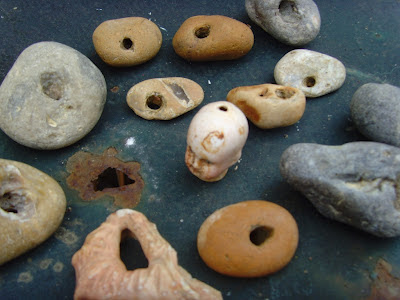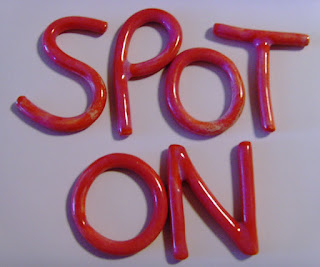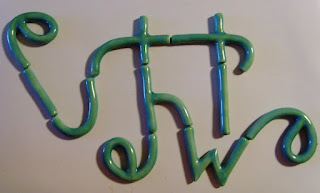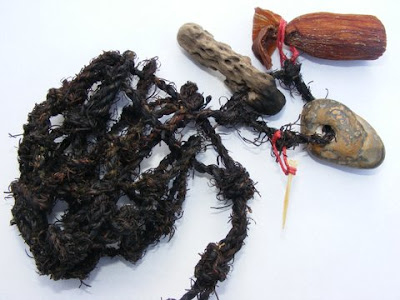The theme of amulets and power objects is a line of enquiry I've been exploring in different ways for some time. I made my first amulet for FULL CIRCLE, a group exhibition with Hertfordshire Basketry, in 2009. It was a small circular form made using a five-rod spiral plait closed with a Japanese knot - the first of many. I've always found this plait spell-binding - the rhythm and repetition of the weave enthrals the conscious mind while the twists and complexities of the emerging spiral bewitch and bewilder the subconscious.
AMULET #1 2009
An amulet is a protective charm which was often worn as piece of jewellery or kept close to the body - either held in the hand, placed in a pocket or in the folds of clothing. My amulet was designed to be worn as a sculptural wrist piece.
I made two related works for the same show. One was a Hex-weave container, the other a large painted wall piece titled INCANTATION. Willow rods, spray-painted through a letter stencil, created vertical lines of indecipherable text. Old dialect words are magical - their derivations obscure and their connotations enchanting. When I was little and would sometimes get a tiny splinter of wood in my finger my grandmother called it a 'spell' and she cast it out with tender care. By a curious inversion my own spellings often result in splintered words!
INCANTATION 2009
I returned to the theme of Amulets in 2011 when I took part in the Hothouse exhibition 'Portraits in the Making' at Pitzhanger Manor Gallery and House. In addition to NOVA, my large-scale work for the Gallery (see previous post), I proposed making a Cabinet of Curiosities for the House itself. Amongst my collection of 'curious mathematical gems' were several amulets.
Amulets were believed to offer protection against a whole range of ills, evils, maladies and malevolent spirits. One type, a stone with a naturally occurring hole through it, would be placed under the pillow to ward off disturbing nightmares in which the sleeper dreams they are being pinned down by a demon or witch. The old-English word for witch is hag - hence the term hag-ridden - and the amuletic stone is thus known as a hag stone. I once, thankfully only once, experienced such a nightmare - which is now thought to be caused by a fairly common neurological condition referred to as sleep paralysis. The fact that there's an old-English term to denote it suggests that many others have suffered over the centuries and sought solace in a protective charm when all else failed.
I made a whole set of spiral plait hag stones, some of which were dipped in porcelain slip, fired, and thereby literally turned to stone.
Porcelain GHOST STONE
Other amulets contained porcelain letters made for me by ceramicist Rosanna Martin. I chose porcelain for all these pieces because Chinese porcelain - once a rarity considered more precious than gold, was often housed in Cabinets of Curiosity.
I enjoyed a bit of word play before enclosing the letters in the plaited structures and loved the way the lower case letters in particular could be laid end to end to create meandering lines reminiscent of ancient runes. It was like being a kid again making up secret messages. I later discovered that talismans, or written charms, derive potency from being indecipherable to the uninitiated - a curious connection with my stencilled willow Incantation.
CORAL AMULETS containing porcelain talismans 2011
I wanted to develop the idea of making a talisman using porcelain letters as my amulet for the Petrie Exhibition. Many Egyptian amulets in the Petrie collection were made of faience (glazed pottery) beads. There are numerous other examples made from more precious materials such as gold, red coral and carnelian. My talisman ONE FOR SORROW was to be a spell to ward off magpies - the human kind who would steal away our most precious jewels to feather their own nests. Silence is golden but not if your creative voice is stifled or distorted through raucous mimicry.
Once again I asked Rosanna Martin to make the letters and this time the porcelain was decorated with red on-glaze enamel and gold lustre.
One for sorrow, two for joy,
three for a letter, four for a boy,
five for silver, six for gold,
seven for a secret never to be told.
There are many regional variants of this rhyme which makes reference to superstitions regarding the magpie's power as a totem animal endowed with the gift of prophesy. In our family the more usual 'three for a girl' was changed to 'three for a letter'.
Visitors to the Petrie exhibition might well ask, 'where are the baskets?' or wonder where the connection lies between basketry and amulets. As contemporary basket makers, several members of Basketry Plus, myself included, have moved away from making functional containers and prefer instead to experiment with basketry construction techniques as a medium for creative expression. The weave is what connects us as a group and the power of the weave is our connection to the protective power of amulets. As Maggie Smith, one of our group members, discovered when researching her amulet - it's basketry techniques themselves, especially those that involve the twisting and knotting of fibres, that were believed to trap evil spirits through perplexity.
The basketry element of ONE FOR SORROW - Amulet #9 of the 13 AMULETS is open hexagonal plaiting, otherwise known as hex-weave. It both protects and obscures the talisman beneath. I've given away only the title - there are more spellings and I defy anyone to crack the code.
The exhibition continues until May 31st 2012.
Here's a taster of some of the other amulets for anyone who can't make it.
Amulet #10 KEEP SAFE MY LOVE by Suni Lopez
STRANDLINE Amulet by Maggie Smith including a bag of sand to protect against witches - a witch must pause to count the grains of sand before she can enchant the weaver. (note the hagstone!)
Detail of SAFE DELIVERY - a childbirth amulet by Joyce Hicks, including a looped bag in the form of the Egyptian hieroglyph for basket.
DIVINITY - an amulet by Joan West. The form is based on the Eye of Horus - a powerful charm against the evil eye.
There will be an artists talk and demonstration at the Petrie Museum on May 10th from 6.30-7.30pm ALL WELCOME
Many thanks to Debbie Challis at the Petrie Museum for all her efforts in helping put on this exhibition and for hosting the talk.
















